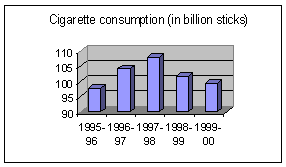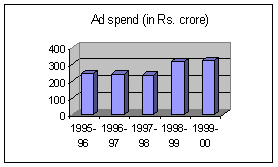Ban on Tobacco Ads by the Government of India
 |
Details
Themes: Ethics in Business
Period : 1981-2001
Organization : Indian Tobacco Company Philip Morris
Pub Date : 2001
Countries : India
Industry : Food, Beverages & Tobacco
<< Previous
The Nays' Contd...
FIGURE II
CORRELATION BETWEEN CIGARETTE CONSUMPTION AND AD SPEND
|
|
|
In the US, a study10 was done to examine the relation between cigarette advertising and consumption between 1961-90. The finding was that "aggregate advertising expenditure and total consumption of cigarettes in the United States were not significantly related from 1961-90." An advertising ban was implemented in Norway in 1975, but consumption of tobacco remained virtually unchanged from the period before the ban all the way through 1995. Researchers from the Norwegian National Council on Smoking and Health11 who compared smoking trends in Norway with those in seven other European countries, also found that Norway had the highest per capita proportion of adult smokers among all the countries surveyed. |
|
The Haze
Tobacco consumption was growing in the developing countries while it was falling in the developed countries. Concerned over the welfare of its citizens, who were fast becoming a prey, the Indian government decided to ban advertising by tobacco companies as a first step towards its goal of discouraging smokers. But the advocates of free choice and the cigarette companies (the worst hit in the tobacco industry when the ban was imposed) insisted that ban was no solution to the problem.
Said Shunu Sen, CEO, Quadra Advisory, "Excess of anything is bad. Excess of coffee, tea...whatever. Where do we draw the line?" They argued that that the ban was unjustified, as advertisements didn't promote smoking, and that the ban was not the right solution to the problem. The Cigarette companies expressed concern that the ban would deny them level-playing field.
The issues discussed above at best gave an idea of how complex the problem was. This was the crux of the problem. The problem itself seemed so intricate as it questioned the very domain of propriety; both ethical and commercial and the 'ifs and buts' were too hazy and one too many. No wonder the debate over the state control on tobacco consumption was clouded in an enigmatic tussle-a tussle between rhetoric and plain talk, of arguments and counter arguments, of claims and counter claims. Only time would say who would have it, the Ayes or the Nays.
10] Excerpts from Advertising and Markets, eds. J. Luik and M. Waterson, NTC Publications Ltd. (1996).
11] Kraft, P., Svendsen, T., "Tobacco Use Among Young Adults in Norway, 1975-95: Has the Decrease Levelled Out?" Tobacco Control (1997).
12] Steward, M.J., "The Effect on Tobacco Consumption of Advertising Bans in OECD Countries," International Journal of Advertising, 12: pp. 155-180 (1993).

